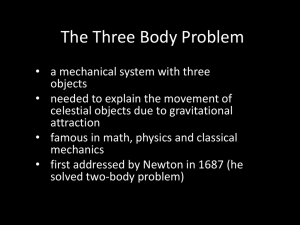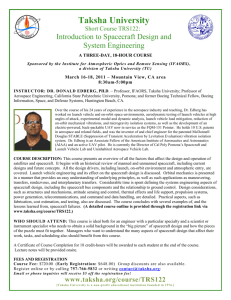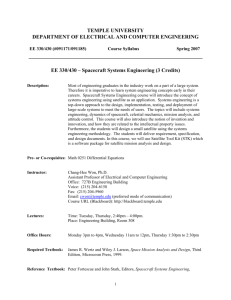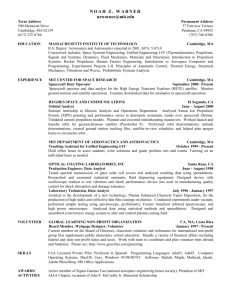Test Mission Planning Status - E-sail
advertisement
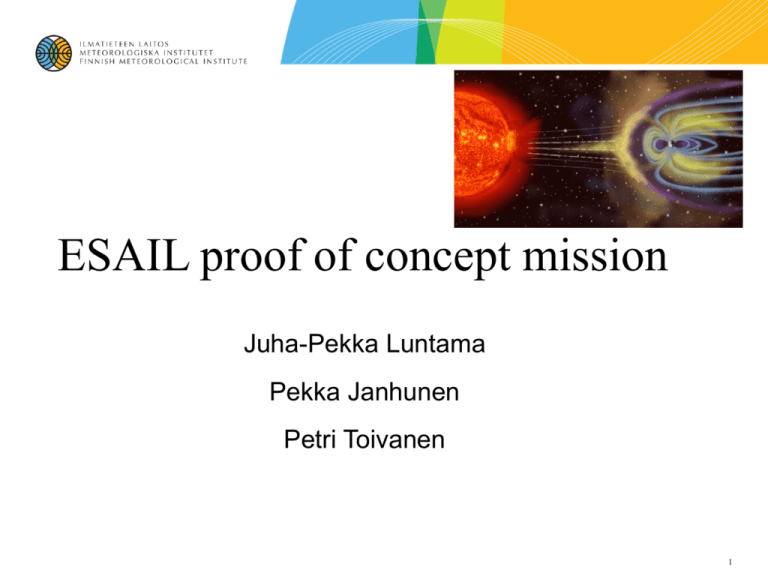
ESAIL proof of concept mission Juha-Pekka Luntama Pekka Janhunen Petri Toivanen 1 Outline 1. 2. 3. 4. 5. 6. 7. Introduction Mission objectives Magnetosphere Mission elements Expected mission results Demo mission schedule Summary 2 Introduction • The physical background of the electric sail concept has been carefully studied and simulated • Sail manufacturing and deployment techniques are under development • Remaining problem: Electric sail can not be tested or demonstrated on the Earth surface => A concept demonstration mission is needed • to verify the analysis and the simulation results • to demonstrate the feasibility of the sail deployment and control • to test advanced concepts to improve electric sail efficiency 3 Mission objectives • Main objectives: – Successfully deploy and operate an electric sail in space – Measure the acceleration of the spacecraft in different solar wind conditions – Test enhancement of the sail efficiency by electron heating • Secondary objectives: – Many technical and scientific objectives considered: • Monitoring of the electric sail behaviour in the dynamic solar wind conditions • Spacecraft attitude control • Characteristics of the solar wind near the sail • Dust particle monitoring • … – The secondary objectives will be carefully assessed and selected based on the mission partners and main mission profile => focus in strictly on the main mission 4 Earth’s magnetosphere • Electric sail does not work (at least well) within the magnetosphere • Even outside the magnetosphere the solar wind is disturbed e.g. in the foreshock region apogee of the test mission orbit has to be well outside the magnetosphere the shortest distance to undisturbed solar wind is towards the sun 5 Elements of a proof of concept mission • Pre-phase A analysis – Payload – Spacecraft bus – Orbit – Launcher – Ground segment – Lifetime – Budget 6 Test mission payload • Main payload: Electric sail prototype – Sail: 8 X 1 km aluminium four-fold Hoytethers – Mass estimates: • Tethers: < 0.1 kg (25 µm) • Reels: 4.0 kg • Electron gun + radiator: 1.5 kg (40 kV & 1kW) • High-voltage power source: 2.0 kg • tether direction sensor: 2.0 kg • Spinup thrusters: 3.0 kg • Accelerometer: 0.5 kg 2 km • Ion and electron detector: 1.5 kg • PCU: 0.5 kg • Total: 15 kg 7 Spacecraft bus requirements • Essential requirements: – Spinner: spin rate 3 min per rotation – 200 W electric power – Spin control during sail deployment – Ground link from 46 Re (telemetry and telecommand) – Propulsion for reaching final orbit – Tether reels minimum of 30 cm radial distance from the spin axis – Cooling for the electron gun • Other requirements – Depend on the mission secondary objectives 8 Spacecraft requirements analysis • Spinner => symmetrical spacecraft, fixed solar panel • Very small payload => spacecraft mass impacts mostly perigee kick motor sizing • Electronics radiation hardened due to solar particles and Earth radiation belts • Spinup thrusters and tether reels benefit from the radial distance from the spacecraft rotation axis • Spacecraft spin axis points approximately to the sun direction during the main mission => spacecraft body can be used to shield the electron gun 9 Test mission spacecraft outline • Mission requirements can be fulfilled with a relatively simple, small weight spacecraft • Spacecraft body should have a relatively large diameter and a large sun pointing surface => spherical or octagonal cylinder with a diameter of 1 m • Payload constraints on the spacecraft body are modest => final design will depend on the launch vehicle and potential secondary payload instruments 10 Orbit selection criterias • Essential requirements: – Apogee well outside the magnetosphere – Mission life time minimum of 1 month – No passes through densely populated satellite orbit regions (our spacecraft has effective diameter of 2 km) • Important aspects: – No need for orbit maintenance – Simple spacecraft design => spin axis point to the sun – Minimize launch cost • Nice to have: – Option to perform other space science observations 11 Other orbit aspects • Extremely elliptical orbits unstable due to the Moon => either active orbit control or short mission lifetime • Final orbit not reachable without a perigee kick motor => Spacecraft design more complex => Up to 75% of launch mass fuel => Longer and more complex LEOP phase due to orbit manoeuvres • High initial orbit (e.g. GTO) => less fuel needed => higher launch costs • Satellite visibility => ground station antenna location 12 Orbit candidates Equatorial orbit Low/medium inclination orbit Apogee radius: 47 Re 47 Re Perigee height: 2800 km 2800 km Inclination: 0 0 - 45 Orbit period: 7 days 7 days Deceleration zone Sun Acceleration zone Moon orbit Bow shock 13 Launcher options • Final orbit requires the use of a perigee kick motor => launch to either LEO or GTO • Demo mission spacecraft: – dry mass << 100 kg – fuel from LEO to final orbit: 75% of the launch mass => launch mass 200 – 400 kg • Piggy-back opportunities to be exploited => GTO orbit orientation potential limitation • Dedicated small launcher allows mission lifetime optimisation 14 Ground segment • Apogee height of 47 Re allows spacecraft control even from a high latitude station • No satellite link during the perigee pass => Single ground station, operations during “office hours” • One potential scenario: – Satellite ground station in Sodankylä, Finland – Mission control center at FMI premises – Mission operations by FMI staff – LEOP supported by launch provider – Data processing and analysis by mission partners 15 Mission lifetime • Main limiting factors: – Orbit stability – Apogee direction • Main mission objectives can be achieved during one month of experiments • Conservative mission plan: => a three month mission with the “prime time” during the second month • Next suitable observation period in 9 months => main mission objectives do not support extension of the mission life time beyond 3 months 16 Mission “prime time” definition Mission end Prime time Mission start Launch and LEOP 17 Mission budget estimate • Spacecraft bus: 2 M€ • E-sail payload: 1.5 M€ • Launch: 1 M€ • Mission operations: 0.5 M€ • Notes: – The budget outline has been estimated by assuming that all components can be procured based on competitive tenders. – Maximize the use of existing facilities – The spacecraft bus and the payload are produced and tested with reduced requirements policy 18 Expected mission results Main mission objectives • Successful deployment of E-sail tethers • Successful observation/direction sensing of tethers • Detected spacecraft acceleration: > 4E-6 m/s2 • Validation of E-sail theory: Dependence of acceleration on voltage and solar wind conditions • Electron heating test: Dependence of acceleration on A/C modulation of electron beam, for different frequencies Secondary objectives • E.g. monitoring of the dust particle hit rate and size distribution (effective detector area 1.7 m2, i.e. largest ever flown) 19 Demo mission schedule • One of the main schedule drivers is the development of the tether production line • Estimated payload delivery time after the tether production capability exists is 1 – 1.5 years • Launch could take place within 6 months from the payload delivery • Nominal mission duration including LEOP is 4 months • Satellite will be deorbited at the end of the mission 20 Summary • Electric sail concept requires a test mission to: – Demonstrate deployment and operations of the sail in space – Measure the acceleration of the spacecraft in different solar wind conditions – Test enhancement of the sail efficiency by electron heating • Demonstration mission can be performed with a reasonably small, simple and inexpensive spacecraft <=> mission design driver is the need to fly outside the magnetosphere • Life time of the demonstration mission is only 4 months • E-sail demonstration can be combined with other space physics observations • Mission can be performed in 2 years from development of the tether manufacturing capability 21
